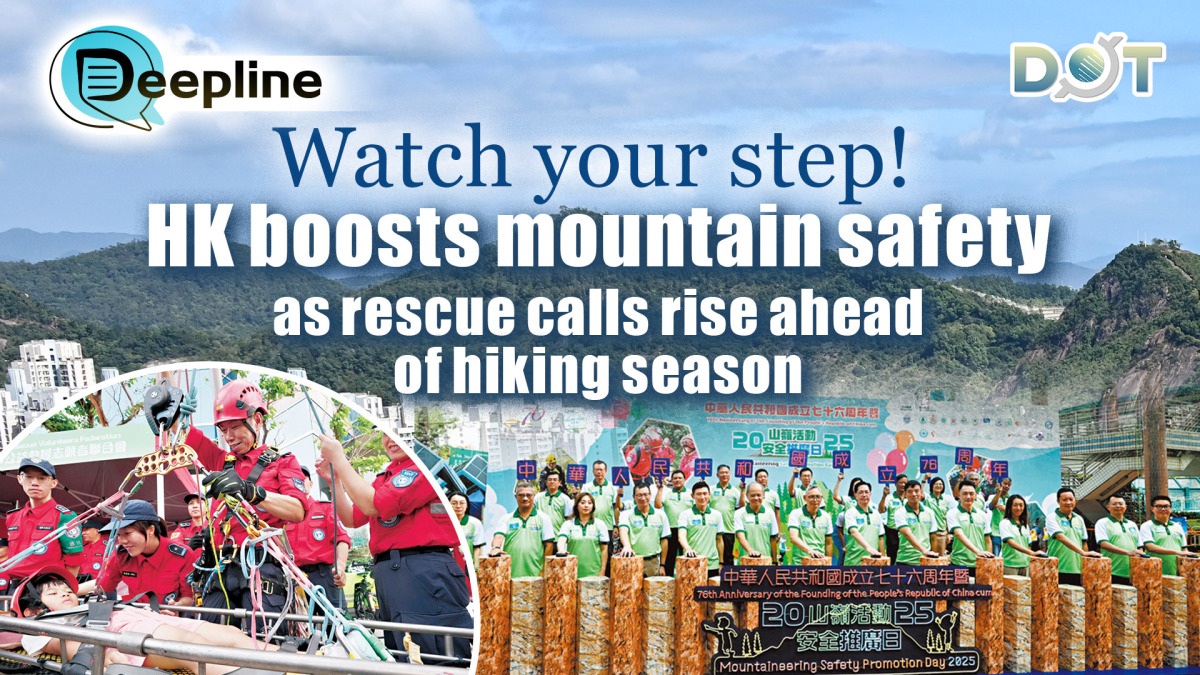
The autumn hiking season is approaching, coupled with the SAR government's active promotion of "Four Peaks" Tourism, it is believed that this will attract a large number of citizens and tourists to engage in mountain activities. To enhance public awareness of mountain activity safety and reduce mountain accidents, the Civil Aid Service (CAS), together with multiple government departments and mountain activity organizations, held a mountain activity safety promotion day in Quarry Bay Park yesterday (Oct. 19).
The CAS stated that so far this year, they have conducted over 50 mountain rescue operations, surpassing the total number for last year, with many of those seeking help being solo hikers. The CAS will trial drone patrols in Sai Kung and strengthen safety promotion among tourists. Under Secretary for Security Michael Cheuk also urged the public not to disregard safety and venture into dangerous spots for the sake of taking photos.
In his opening speech, Cheuk said that with the current administration actively promoting tourism development, more tourists are coming to Hong Kong to explore natural landscapes. However, many people cross barriers into dangerous areas or venture into undeveloped zones for photos, disregarding their own safety.
He emphasized that although some might consider such behavior self-inflicted, rescue personnel will still risk their lives without hesitation to save them. Still, he called on citizens and tourists to take responsibility for their own safety and not put rescue personnel in danger.
Sai Kung to trial drone patrols
Cheuk further stated that with the development of the low-altitude economy, various government departments have begun using drones to assist in search and rescue operations. After assessment by the Civil Aviation Department, the CAS's pilot project will conduct tests in Sai Kung's Tai Tan and Yuen Tun Camp.
Additionally, given the frequent extreme weather in recent years, post-natural disaster recovery work is very important. Rescue personnel will also actively participate in restoring work on fallen trees after mountain accidents.
Collaboration with AFCD on extreme weather conservation work
Chief Staff Officer of the CAS, Leung Kwun-hong, revealed that the CAS will collaborate with the Agriculture, Fisheries and Conservation Department (AFCD) and other government departments to carry out post-extreme weather and storm mountain surveys and conservation work. Furthermore, the CAS maintains close contact with the Hong Kong Observatory (HKO) to get the latest weather information in advance, allowing for better preparatory measures.
The CAS handled 76 and 43 mountain rescue operations in 2023 and 2024, respectively, but the number has increased to over 50 so far in 2025. Leung believes this rising trend is related to several factors, including this year's hot weather easily causing dehydration and heatstroke among hikers, as well as increased public awareness of hiking safety, making them more willing to call the police promptly when in danger.
Overall, however, the promotion of "HKSOS" is one of the key reasons. After users log into the platform, the system records their real-time location, and in case of emergencies, it can immediately alert departments such as the police, fire services, and the CAS.
Safety Promotion for "Four Peaks" Tourism
In recent years, the SAR government has actively promoted "Four Peaks" Tourism, and patrol work and safety promotion have been simultaneously strengthened. Leung revealed that besides having the CAS Mountain Search and Rescue Company and the Government Flying Service on standby at their bases on weekends, they also proactively conduct patrols and safety promotion work in different areas. For instance, during peak periods like the National Day "Golden Week," the CAS increases patrols in places like Po Pin Chau. Recently, they successfully assisted in two cases where hikers were in danger.
Regarding tourist groups, the CAS primarily uses social media platforms like Xiaohongshu to disseminate hiking safety knowledge. They also briefly publish details after each rescue operation so that tourists can understand the importance of mountain safety.
First-hand account: Avoid unfamiliar routes!
The CAS also invited a university student who was rescued after encountering danger while hiking and a team member involved in the rescue to share their experiences. Lee and his friend, both students, went hiking on Lamma Island around noon, bringing two bottles of water and wearing ordinary shoes and shorts. Originally planning a 4.5-hour hike, they found themselves running out of drinking water halfway and decided to turn back early.
During their return, they found a path on the map that seemed shorter, "because it could cut across the mountainside and reach the other side of the hill." Unexpectedly, the route was far more difficult than anticipated, requiring them to traverse dense forests, climb 60-degree steep slopes and cliffs. Eventually, they managed to descend, clinging to the cliff face, but became trapped about 30 meters above the ground, unable to proceed further.
Due to the rugged and dangerous terrain, Lee quickly became exhausted, and his friend developed symptoms of dehydration. He immediately put up a sun umbrella for shade and called 999 for help. Subsequently, several police officers maintained contact with him via WhatsApp. After sending the location information, the rescue operation commenced immediately.
About an hour later, a Government Flying Service helicopter arrived at the scene, but due to the treacherous terrain, it couldn't perform a hoist operation, taking half an hour to find a suitable landing spot. The helicopter then transported several CAS members to a nearby location. The team members, guided by the helicopter's directions, walked to the location of Lee and his friend and brought them to safety.
Lee praised the rescue team for their professionalism and urged other hiking enthusiasts not to take unfamiliar or undeveloped routes.
A team leader who participated in the operation added that the information received with the call was limited. Although they obtained coordinate locations, they couldn't immediately verify their accuracy and had to assess the terrain on-site. Therefore, when the CAS arrived at the scene, they brought sufficient hiking equipment, striving to complete the rescue before nightfall.
"Because once night falls, the dangers in the mountain environment increase significantly, and the physical exertion for both of them and the rescue team members also increases substantially, so the operation must be swift."
The leader reminded the hikers not to underestimate the terrain and overestimate their own abilities.
(Source: Wen Wei Po; Journalist: Lee Tsz-shan; English Editor: Darius)
Related News:
Deepline | HK's aging crisis: Soaring public healthcare costs spark urgent reform
Deepline | Digital immune system: How HK banks are fighting AI with AI




















Comment